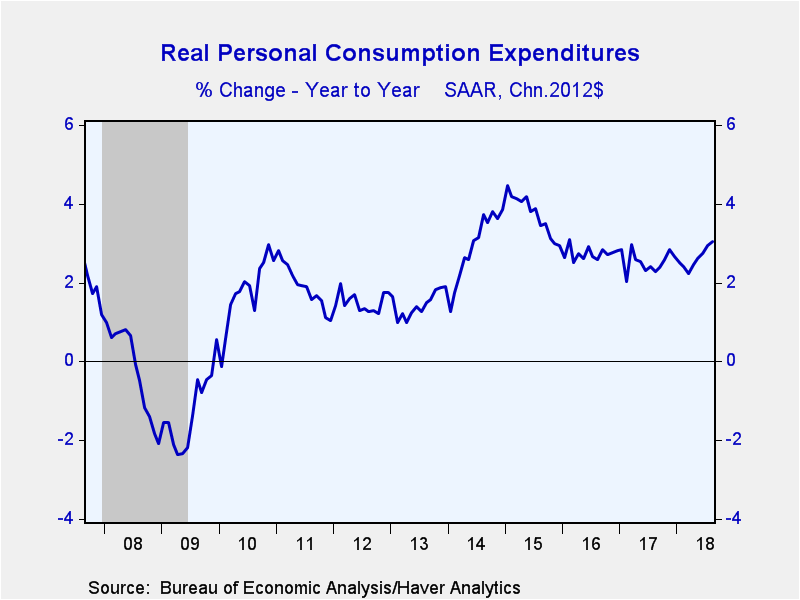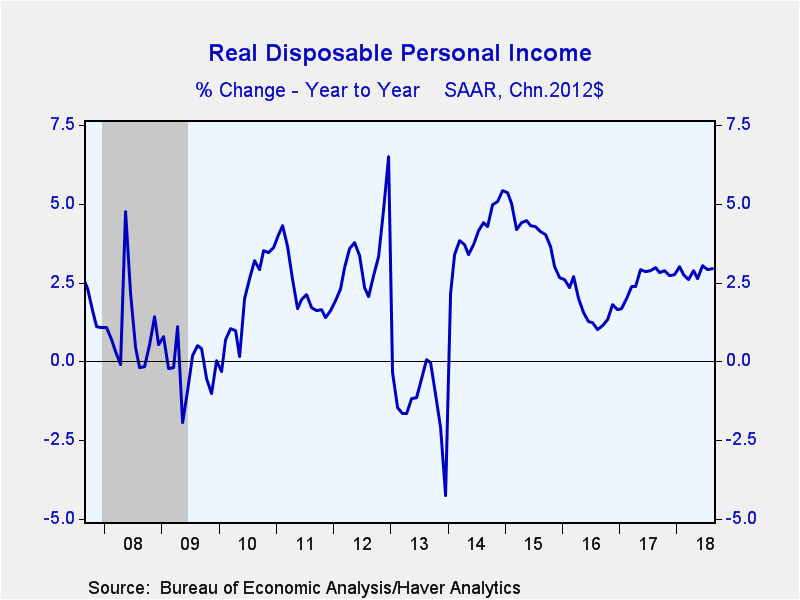 Global| Sep 28 2018
Global| Sep 28 2018U.S. Personal Spending and Income Post Solid Gains in August
by:Sandy Batten
|in:Economy in Brief
Summary
Personal consumption expenditures rose 0.3% (5.3% y/y) in August following an upwardly revised 0.5% m/m gain in July. Personal income also rose 0.3% m/m (4.7% y/y) in August, the same monthly increase as in July. The Action Economics [...]
Personal consumption expenditures rose 0.3% (5.3% y/y) in August following an upwardly revised 0.5% m/m gain in July. Personal income also rose 0.3% m/m (4.7% y/y) in August, the same monthly increase as in July. The Action Economics Forecast Survey had looked for a 0.3% m/m increase in consumption and a 0.4% m/m gain in income. In constant dollars, personal spending increased 0.2% (3.0% y/y), a slowdown from the 0.3% m/m rise posted in each of the previous four months. The 3.0% y/y rise in real PCE was the fastest since February 2016. For the first two months of the third quarter, real PCE is on track for a 3.1% q/q annual rate increase from the second quarter--a slowdown from the 3.8% q/q posted in Q2 but still a solid rise that should make a meaningful contribution to overall GDP growth. Disposable income rose 0.3% m/m (5.2% y/y) in August, the same gain as in July. After adjusting for inflation, real disposable income increased 0.2% m/m (2.9% y/y) in August. The saving rate was unchanged at 6.6% in August. Personal saving was up 2.4% from a year ago.
Looking behind the gains in total real PCE, real spending on durable goods rose 0.2% m/m (6.4% y/y) despite a 0.3% m/m decline in spending on motor vehicles and parts. Real spending on nondurable goods increased a solid 0.4% m/m (3.3% y/y). Real spending on services increased 0.2% m/m (2.5% y/y), the same monthly gain as in July. Real spending on energy fell 0.3% m/m (+1.0% y/y), its third monthly decrease in the past four months. Real spending on food services and accommodation (a good indicator of discretionary spending) slipped 0.1% m/m (+5.5% y/y) in August after having posted three consecutive monthly gains in excess of 1% m/m.
The 0.3% m/m increase in personal income was led by a 0.5% m/m rise (4.8% y/y) in wages and salaries. The August increase was the largest monthly gain since January. Proprietors' income rose 0.3% m/m (5.1% y/y). Rental income jumped 0.8% m/m (5.0% y/y), its largest monthly gain since last October. Income from assets slipped 0.1% m/m in August, its second consecutive monthly decline, but was 5.5% higher than a year earlier.
The chain type price index inched up 0.1% m/m for the third straight month. The y/y rate slipped to 2.2% from 2.3% in July. The index excluding food and energy prices (the measure on which the Fed focuses) was unchanged in August from July, as was the y/y rate at 2.0%--the Fed's target. Energy prices jumped 1.9% m/m after having declined in each of the preceding two months. Food prices were unchanged in August (+0.5% y/y).
The personal income and consumption figures are available in Haver's USECON database with detail in the USNA database. The Action Economics figures are in the AS1REPNA database.
| Personal Income & Outlays (%) | Aug | Jul | Jun | Aug Y/Y | 2017 | 2016 | 2015 |
|---|---|---|---|---|---|---|---|
| Personal Income | 0.3 | 0.3 | 0.4 | 4.7 | 4.4 | 2.6 | 4.9 |
| Wages & Salaries | 0.5 | 0.3 | 0.4 | 4.8 | 4.6 | 2.9 | 5.1 |
| Disposable Personal Income | 0.3 | 0.3 | 0.4 | 5.2 | 4.4 | 2.8 | 4.4 |
| Personal Consumption Expenditures | 0.3 | 0.5 | 0.4 | 5.3 | 4.3 | 3.8 | 4.0 |
| Personal Saving Rate | 6.6 | 6.6 | 6.7 | 6.8 (Aug'17) |
6.7 | 6.7 | 7.6 |
| PCE Chain Price Index | 0.1 | 0.1 | 0.1 | 2.2 | 1.8 | 1.1 | 0.3 |
| Less Food & Energy | 0.0 | 0.2 | 0.1 | 2.0 | 1.6 | 1.7 | 1.3 |
| Real Disposable Income | 0.2 | 0.2 | 0.3 | 2.9 | 2.6 | 1.7 | 4.1 |
| Real Personal Consumption Expenditures | 0.2 | 0.3 | 0.3 | 3.0 | 2.5 | 2.7 | 3.7 |
Sandy Batten
AuthorMore in Author Profile »Sandy Batten has more than 30 years of experience analyzing industrial economies and financial markets and a wide range of experience across the financial services sector, government, and academia. Before joining Haver Analytics, Sandy was a Vice President and Senior Economist at Citibank; Senior Credit Market Analyst at CDC Investment Management, Managing Director at Bear Stearns, and Executive Director at JPMorgan. In 2008, Sandy was named the most accurate US forecaster by the National Association for Business Economics. He is a member of the New York Forecasters Club, NABE, and the American Economic Association. Prior to his time in the financial services sector, Sandy was a Research Officer at the Federal Reserve Bank of St. Louis, Senior Staff Economist on the President’s Council of Economic Advisors, Deputy Assistant Secretary for Economic Policy at the US Treasury, and Economist at the International Monetary Fund. Sandy has taught economics at St. Louis University, Denison University, and Muskingun College. He has published numerous peer-reviewed articles in a wide range of academic publications. He has a B.A. in economics from the University of Richmond and a M.A. and Ph.D. in economics from The Ohio State University.










